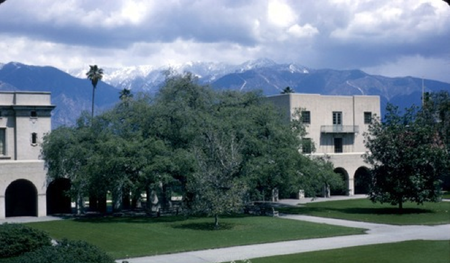Stressed by drought, windstorms, and a systemic fungal infection, the 400-year-old Engelmann oak tree treasured by generations of Institute staff, faculty, and students has died.
The oak, located between Dabney Hall and Parsons-Gates Hall of Administration, had been in declining health for more than a decade despite repeated efforts by campus arborists and outside consultants to prolong its life, says Delmy Emerson, director of buildings and grounds.
"People are shocked and sad," she said about the loss of the oak. "People are so attached to that tree. It's seen the growth of this Institute."
The tree had already exceeded the usual lifespan of an Engelmann oak—about 350 years—and had been stressed by a large and growing cavity in its trunk, possibly the result of physical damage it suffered more than 50 years ago. In the 1990s the tree lost several large branches, necessitating the addition of three structural supports; soon after, it began to require regular delivery of fungicides to its roots to stave off an infection by an incurable soil fungus. Emerson says the loss of another major branch in 2006 eliminated much of the tree's canopy, leaving it vulnerable to additional stress from the sun's heat; to help keep it cool, campus workers painted parts of the tree white.
"A lot of arborists would have removed the tree then, but we decided to let it live as long as it could," she says. "We take our trees seriously, and we only remove one when there's nothing left we can do."
The weather in early 2016 brought rainstorms followed by heat—conditions that favored fungal growth. They also triggered a burst of new green-leaf growth, which, paradoxically, indicated that the tree was burning through its nutrient reserves at a time it should have been dormant, Emerson says. Tree samples taken soon after showed widespread necrosis of its bark and roots, and a last-ditch effort to save the tree using 23 injections of fungicide failed.
In the Institute's early years, the oak provided shade to students and spectators at graduation ceremonies in front of Throop Hall. In more recent years, it has served as a backdrop for countless wedding photos and also served as a subject of portraits drawn by students from the ArtCenter College of Design.
The tree, which once stood as high as 80 feet and spread its branches as wide as 75 feet, will need to be removed. The Institute, however, is investigating ways to salvage some of the wood for use in artwork or furniture as a way to commemorate an oak that has always been a key part of the Caltech campus.
A town hall meeting will be held at noon on Wednesday, February 15, at Avery Dining Hall to discuss proposed plans to commemorate the tree and solicit suggestions for the future use of both the tree's remains and its location.
 The Engelmann oak as it appeared in 1965.
Credit: Courtesy of Caltech Archives
The Engelmann oak as it appeared in 1965.
Credit: Courtesy of Caltech Archives

